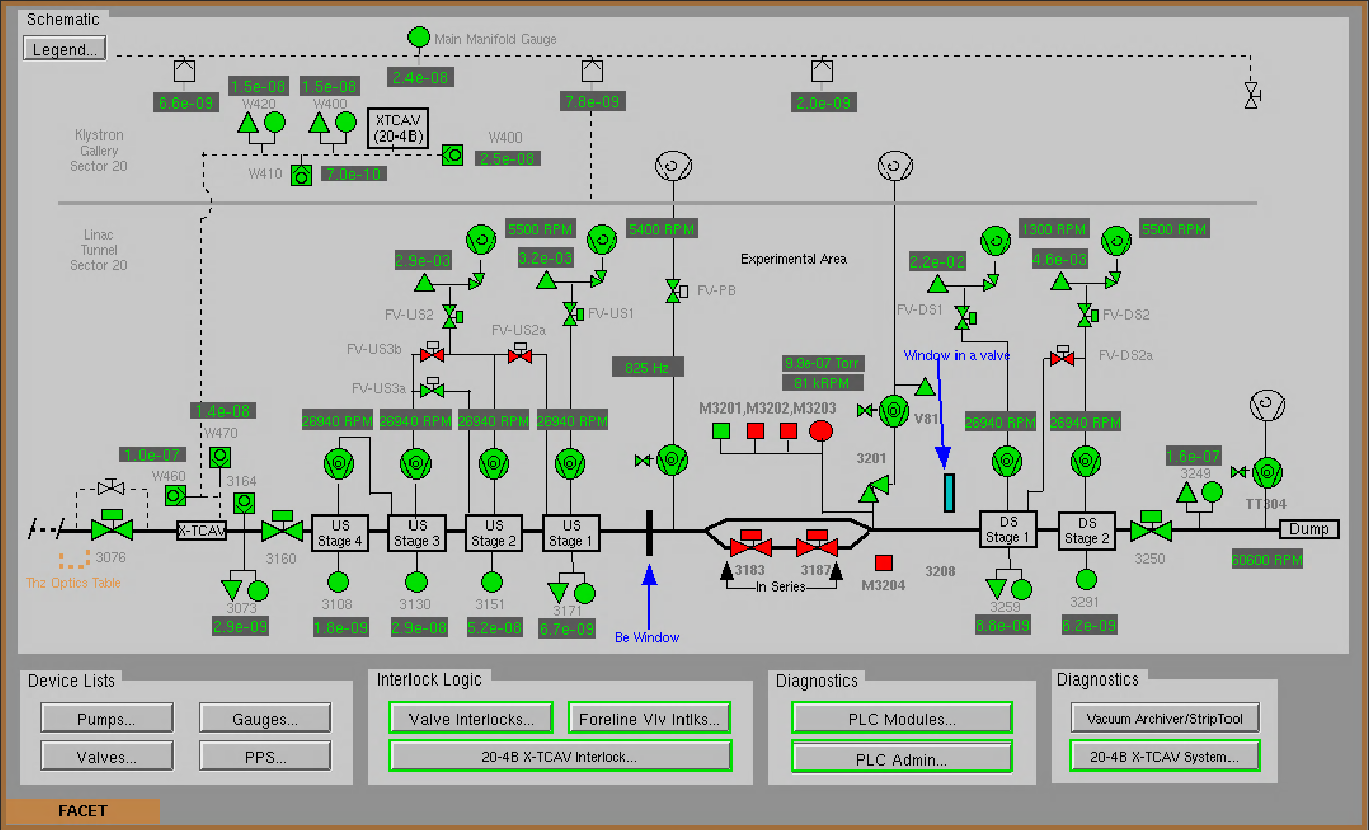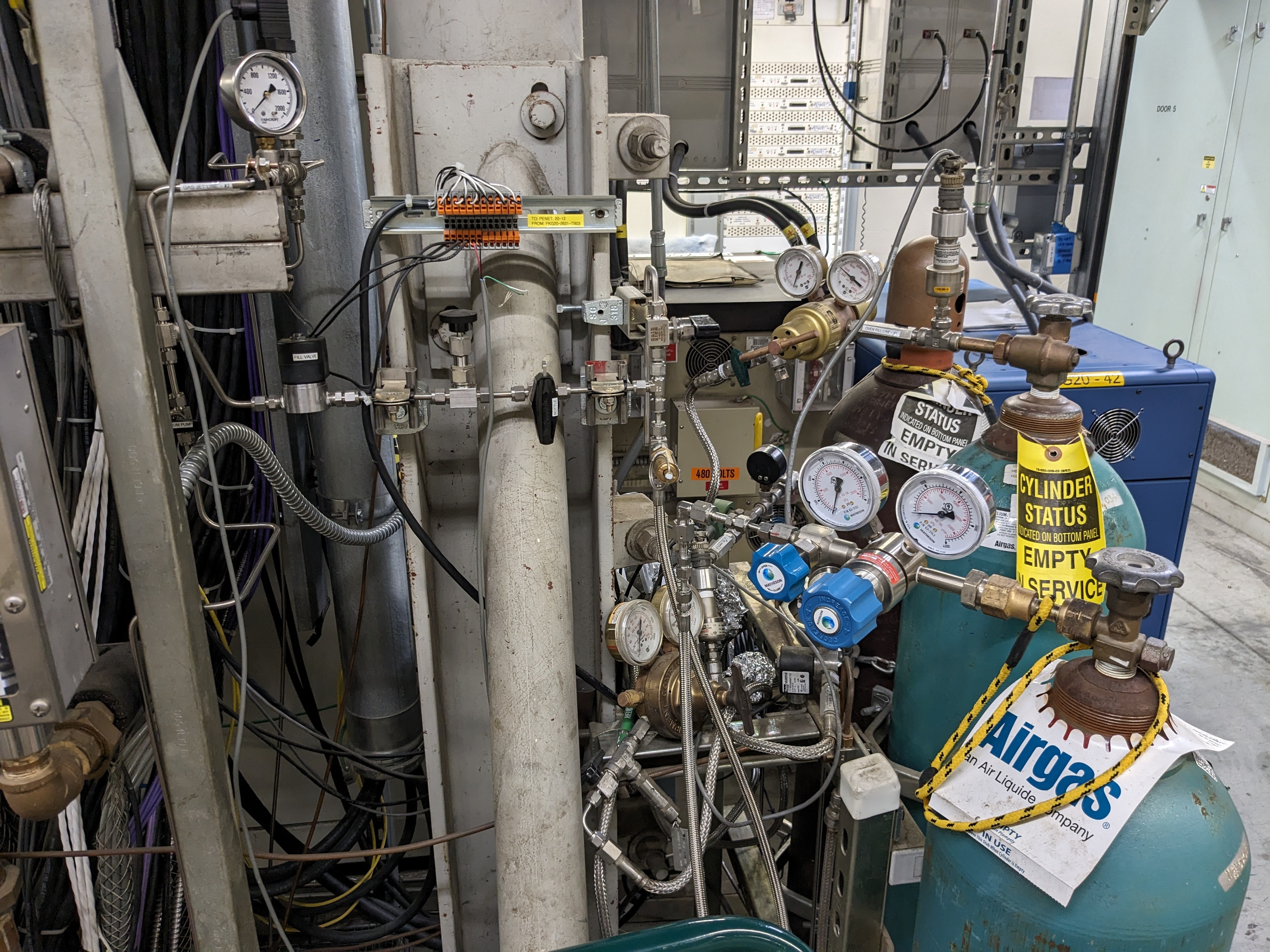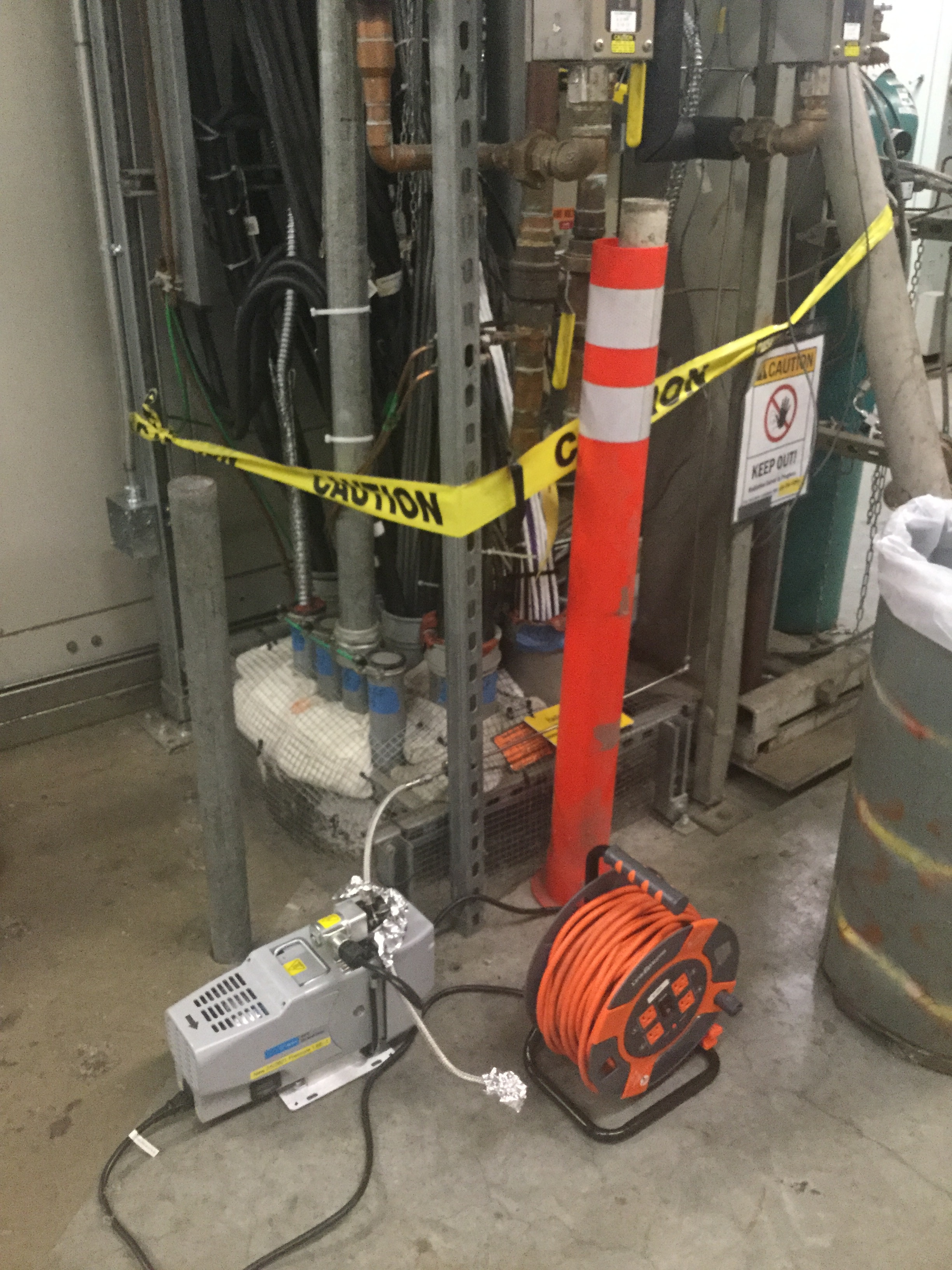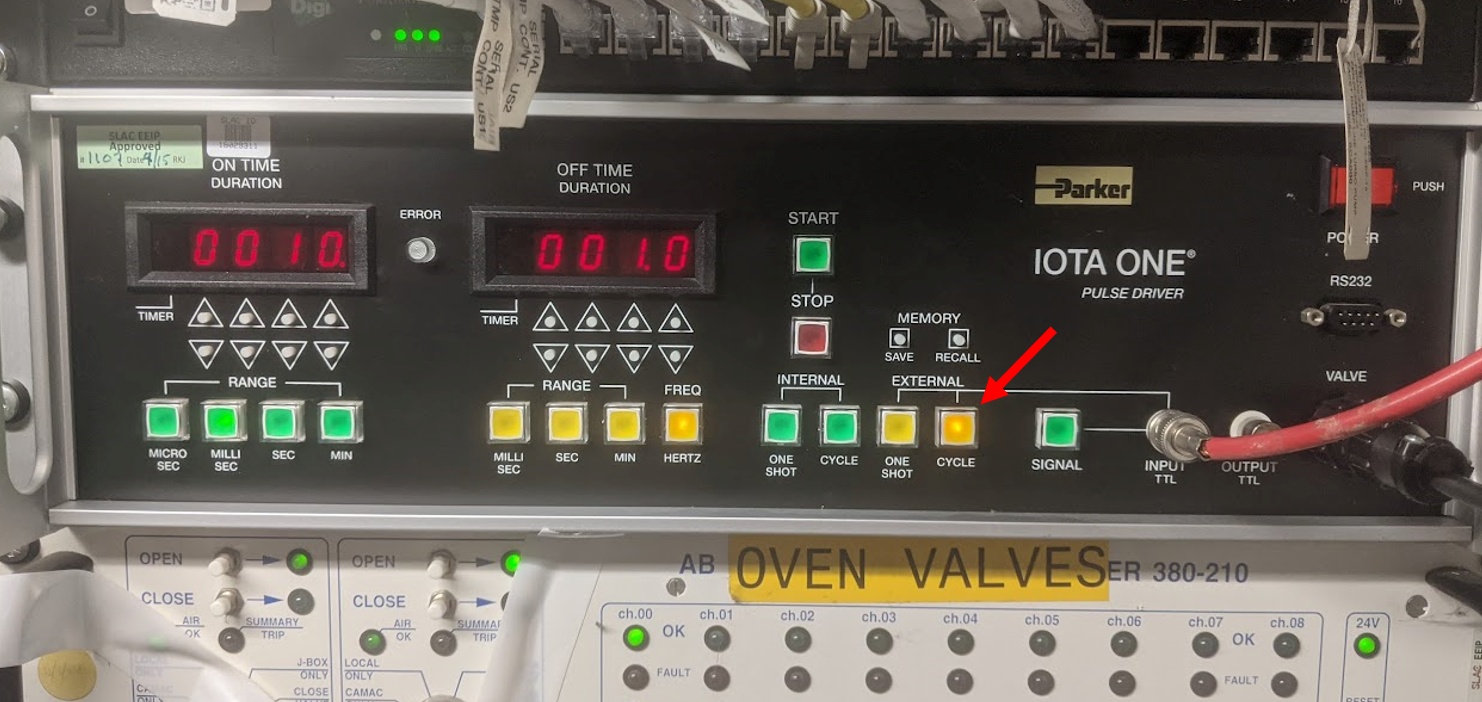These are the new instructions for how to use the gas jets. This procedure will supersede the "How to use gas jets" and "How to DPS with gas jets" pages.
| Table of Contents |
|---|
Hardware requirements:
- Gas bottle of selected gas species. Needs to have >1200psi if you plan to run the jets that high
- N2 available in the 6 pack if you plan to run with H2
- Regulator - there are multiple available
- 100 to 1200 psiG (max 3000psiG, but we only run up to 1200)
- -30psiG - ?? psi (for low pressure, and the ability to run to real 0, not 0 psiG
Step-by-step guide
1. Prepare the DPS system
- Verify both US-DPS and DS-DPS pumps are running and operating as normal.
- Also check VPIO:LI20:3164 to ensure the ion pump is on.
- Figure 1 shows how the DPS looks under nominal operation.
- Start a strip tool and load the file: DPS_Gasjet_Pressures.stp
- Find the VGCM:LI20:M3203:PMONRAW pressure - this is the 10 Torr capacitance manometer gauge that will provide the IP pressure.
- Ensure the 10 Torr CM gauge is zeroed: VGCM:LI20:M3203:P should be reading 0 Torr on the strip chart.
- If not - this must be zeroed using the rack controller.
- If not - this must be zeroed using the rack controller.
- Find the VGCM:LI20:M3203:PMONRAW pressure - this is the 10 Torr capacitance manometer gauge that will provide the IP pressure.
- Leave the downstream Be window OPEN, this will help
- NOTE - this advice could change after the full characterization of the gas jet if it is found to be more beneficial to close the window.
- NOTE - this advice could change after the full characterization of the gas jet if it is found to be more beneficial to close the window.
- Open the gas jet control panel from facethome: LI20 → Experiment → Gas Jet Controls... (Figure 2)
- Ensure the "Gas 1&2 supply" is green - this tell us that the EPS has not faulted. If it is red, try clearing the fault by hitting "EPS RESET". More details on the interlock statuses can be found in the "E300 Oven..." page
- Set the foreline pump speeds to MAX
- Set the gas type to Helium. There is no calibration curve for hydrogen, so use helium for both He or H2.
- If using hydrogen gas, then set the US1 and DS1 purge gas valves to ON (you will need to open the N2 gas bottle in the gallery later on)
- In the gallery:
- Zero the 10 Torr capacitance manometer gauge if necessary.
- If using hydrogen: Start the purge gas flowing - open the nitrogen 6 pack main valve and ensure that there is ~10 PSIG pressure on the regulator. Check the other in-line valves are open
- You can verify the flow is flowing by opening: DPS Full Schematic → US1 and DS1 roughing pumps → More..., and read the "N2 Flow" PV. It should be reading ~4 Pa.m3/s
- You can verify the flow is flowing by opening: DPS Full Schematic → US1 and DS1 roughing pumps → More..., and read the "N2 Flow" PV. It should be reading ~4 Pa.m3/s
- Prepare the gas delivery - next section.
Figure 1: Nominal vacuum state, before gas jet operations
Figure 2: Gas jet control panel
2. Prepare the gas delivery
- In EPICS, from the Gas jet control panel - open the "Gas jet fill valves..." and ensure all are "OFF"
- In the gallery:
- Connect the gas bottle: Figure 3 -IF YOU DON"T KNOW WHAT YOU ARE DOING, THEN DON'T DO IT!!
- Ensure that your chosen regulator is connected to the fill line. If not, the change this.
- You MUST have training from Juan to change the regulator (VCR connectors)
- Connect the chosen regulator to the bottle
- You MUST have course 172 - Compressed Gas Safety in person training to change bottles/regulators
- Pressure the regulator to the desired operating pressure
- You MUST have course 122 - Pressure System Operator web training to operate the regulator
- Ensure that your chosen regulator is connected to the fill line. If not, the change this.
- Check that the tiny scroll pump by penetration 20-12 is running- Figure 4
- It vibrates slightly, so you can feel it with your foot
- Open the manual valve on the fill line labeled "Bottle".
- Drain the fill line
- Open the manual valve on the fill drain line labeled _____
- Open the drain valve (On) in EPICS and leave for a few minutes to evacuate the line of anything present in it
- Close the drain valve (Off)
- Close the manual valve to the scroll pump. The This valve will need to be opened to totally evacuated evacuate the gas line at the end of the shift or if you need to change gas species. But isn't needed to drain pressure to lower values.
- Open the fill valve (ON)
- Confirm the second gauge pressure pressure gauge on the fill line (top left in image) rises to approximately what you set the regulator to. It won't be exact. But use Use the regulator at the bottle as the reference pressure NOT this second gauge.
- Turn on the IOTA controller in Rack ____
- Power on
- Set it to use external and CycleEnsure that is is set to use "CYCLE" under the "EXTERNAL" trigger. Not one shot. See Figure XX5. The button that is illuminated should be illuminated (Cycle under External).
- This will allow the jet to fire at the time and width as set in the control system
- Note: You can also set to internal triggers and adjust using front panel for testing.
- Note: You can also set to internal triggers and adjust using front panel for testing.
- Connect the gas bottle: Figure 3 -IF YOU DON"T KNOW WHAT YOU ARE DOING, THEN DON'T DO IT!!
NOTE ABOUT CHANGING THE REGULATOR
The regulator may be changed by disconnecting the VCR fittings. Training from Juan should be undertaken before doing this.
Figure 3: Gas bottle and fill line
Figure 4: Drain line and scroll pump
Figure 5: IOTA controller and it's correct set up
3. How to operate the jet
- Open the Gas jet controls panel in EPICS: LI20 → Experiment → Gas Jet Controls... (Figure 2)
Features:- Gas 1 & 2 Supply: This goes red when the EPS is faulted and closes the EPS valve.
- Gas jet valves...: Opens panel to control the fill, drain, and PB valves.
- E-300 Oven...: Gives more details on the EPS faults.
- EPS RESET: this resets the EPS and opens the EPS valve, and makes the "Gas 1 & 2 Supply" status green.
- Gas Type...: Changes the calibration for gas type. There is no calibration for H2, so use He in this case.
- Rate: Use to select the rate that the jet fires at. Only select one at a time.
- State: Disabled == jet off. Enabled == jet firing
- Width: 1ms (1000000 ns) is standard opening time
- Delay: 15.7ms (15700000ns) is standard delay
- Fire the gas jet ONCE to ensure the jet fires and the DPS responds appropriately.
- Set the rate to 0.2 Hz, set state to Enabled, and wait <5s for IP pressure to spike, the disable the state to stop.
- VGCC:LI20:3108:US4 should stay below 1e-9 Torr
- VGCC:LI20:3291:DS2 should stay below 1e-5 Torr
- VGCC:LI20:3073 should see minimal change and stay below 5e-8 Torr
- Fire the gas jet for a minute or so and watch the strip chart. If all continues to look good then you are good to fire at will.
- Set the rate and fire the gas jet as desired. The table at the bottom of the page can help to set the desired rate.
- For best vacuum behavior, Stop the jet when not actively taking data or tuning.
- Especially, for hydrogen as the gas can build up in the roughing pumps and cause the loss of pumping efficiency and degrading DPS performance over time.
- Especially, for hydrogen as the gas can build up in the roughing pumps and cause the loss of pumping efficiency and degrading DPS performance over time.
TROUBLESHOOTING:
- If the "Gas 1 & 2 Supply" indicator goes red then there is an EPS fault:
- Stop the jets
- Check that there is not a DPS issue
- Wait for the pressure to decrease
- Hit "EPS RESET" to reset the EPS. The gas indicator should turn green
- More details can be found in the E-300 Oven panel
- No need to call ACR for this type of fault
- If the Beamline valve indicators go red, then there is a beamline pressure problem.
- Stop the gas jets
- CALL ACR to let them know what is going on.
- Ensure all the turbos are running - all turbo indicators are green, or see more details in DPS Full Schematic
- Wait for the pressures indicated to decrease and change back to green
- Open the Valve Intlks page (from the LI20 Vacuum page) and reset interlocks, then you can reopen the beamline valve from the DPS Full Schematic page if all valve interlocks are cleared.
- If any turbo indicators turn red then call for help. More details can be found in the DPS Full Schematic
THINGS TO WATCH OUT FOR:
- If the lone cold cathode gauges shut themselves off, then turn them back on. If pressure reads above 1e-3 Torr then turn it back off.
- If a CC gauges on 3171 or 3259 are cycling on and off, then force them to stay off (or on if it is in a safe pressure zone)
- Change the control mode to Off, then turn CC HV off.
- Watch the PB and oven turbo temperatures
- Watch CC3073 to see if it ever changes.
- Watch if the DPS foreline valves trip in and the turbos shut off. If this happens DO NOT TRY TO FIX unless you are Doug, or someone knowledgeable about the DPS system.
4. How to reduce pressure or get into safe state to move the gas jet assembly
5. How to shut down after gas jet operation at end of shift or before changing gas species
Maximum operating rates
Information needs to be updated for the present gas jet conditions
The following chart was acquired 07/15/2023, but with the timing width = 10ms, and no purge gas on the DPS. So this is now obsolete, but included for reference.
| Info |
|---|
Related articles
| Content by Label | ||||||||||||||||||
|---|---|---|---|---|---|---|---|---|---|---|---|---|---|---|---|---|---|---|
|
| Page properties | ||
|---|---|---|
| ||
|






